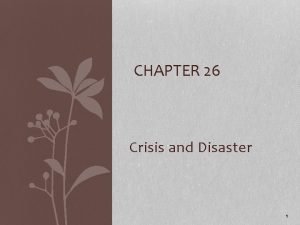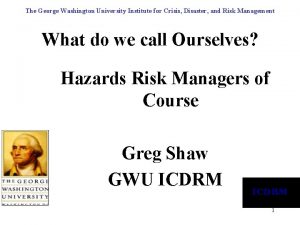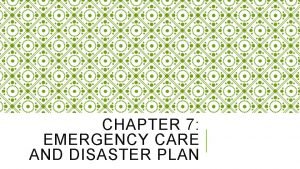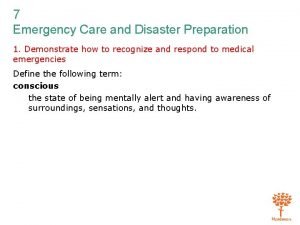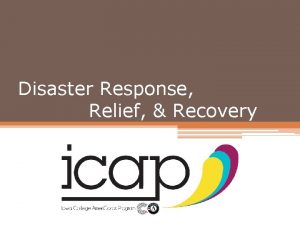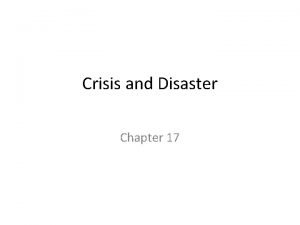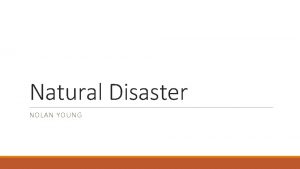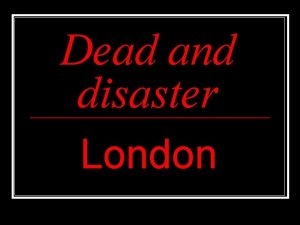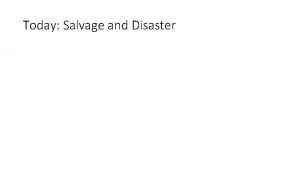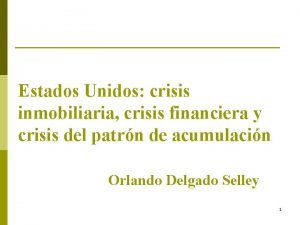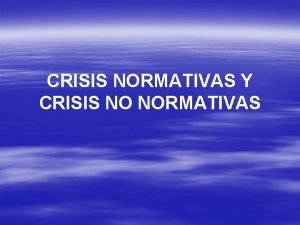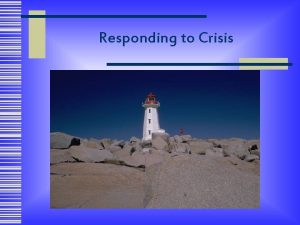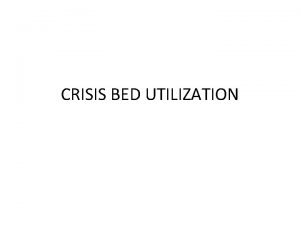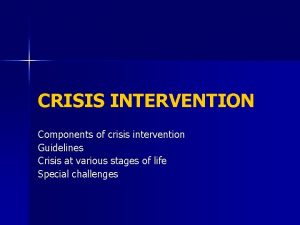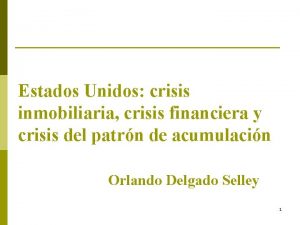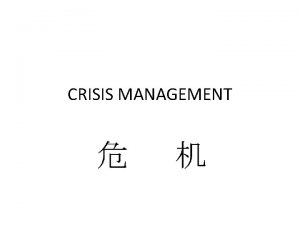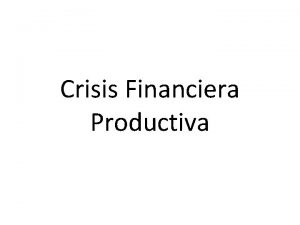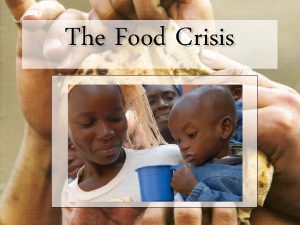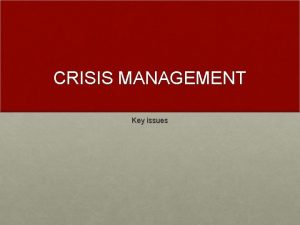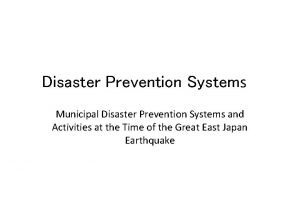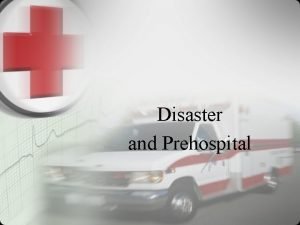CHAPTER 26 Crisis and Disaster 1 Crisis The

































- Slides: 33

CHAPTER 26 Crisis and Disaster 1

Crisis “The Chinese word for crisis is written by joining two ideograms together. These two ideograms make up the Chinese word for crisis. When these ideograms are presented separately they stand for two different ideas or concepts. The first ideograms stands for danger and the second idea grandstands for opportunity. ” (Russell, 1979) 2

Crisis intervention is what nurses and other health professionals do to assist those in crisis to cope. Interventions need to be broad, creative, and flexible. 3

Crisis • Profound disruption of normal psychological homeostasis • A struggle for equilibrium and adaptation • Results in inability to function as usual • Presents opportunity for personal growth • Acute and time-limited • Response to a crisis is a normal not pathologic life experience 4

Outcomes of Crisis • Depends upon • Perception of the event by individual, family, community • Adequate situational supports • Crisis intervention • Adequate coping mechanisms 5

Crisis Intervention Foundations Crisis is self-limiting (4 -6 weeks) Goal of crisis intervention: return to pre-crisis level of functioning During a crisis, people are more open to new problem solving and coping techniques Focus on the immediate crisis only Nurse will be active, even directive Early intervention increases chance for good outcomes Goals should be realistic and mutual 6

Theory • Erich Lindemann (1940 s): Reported Coconut Grove nightclub fire in Boston. • Gerald Caplan (1964): Outlined crisis intervention strategies. • Jefferson Center for Mental Health (JCMH) (1961): Report resulted in crisis centers. • Aguilera/Messnick (1970): Provided framework for nursing crisis assessment and intervention. • Roberts (2005): Seven-stage model of crisis intervention helps in acute situational crisis and acute stress disorder. (Continued) 7

Roberts’s Seven-Stage Model of Crisis Intervention Follow-up plan and agreement Develop and formulate an action plan Crisis resolution Generate and explore alternative Deal with feelings and emotions (including active listening and validation) Identify major problems (including the “last straw” or crisis precipitants) Establish rapport and rapidly establish relationship Plan and conduct crisis assessment (including lethality measures) 8

Case Study Mr. and Mrs. Alessandro are devastated when a faulty ceiling fan causes an electrical fire in their home. Last Wednesday they came home from dinner with friends to find that not only was their home destroyed, but their cat, Alfie, is missing. He hasn’t been since. Insurance is paying for their temporary stay in a tiny apartment for now, but Mr. Alessandro tells you that “the place just adds to my wife’s depression. I can’t get her to do anything with me. Not even take a walk, which she usually makes me do. ” “We do go to the old neighborhood every day, looking for Alfie, but we’re starting to lose hope for him. ” Copyright © 2018, Elsevier Inc. All rights reserved. 9

Clinical Picture: Types of Crisis Three basic types of crises: (1) Maturational (2) Situational (3) Adventitious (disasters) Di e c r vo 10

Types of Crisis • Maturational • New developmental stage is reached • Old coping skills no longer effective • Leads to increased tension and anxiety 11

Types of Crisis (Cont. ) • Situational • Arise from events that are • Extraordinary • External • Often unanticipated 12

Types of Crisis (Cont. ) • Adventitious • Unplanned and accidental • Natural disaster • National disaster • Crime of violence 13

Text Question Ms. T. , a single mother of four, comes to the crisis center 24 hours after an apartment fire in which all the family’s household goods and clothing were lost. Ms. T. has no family in the area. Her efforts to mobilize assistance have been disorganized, and she is still without shelter. She is distraught and confused. The nurse assesses the situation as which of the following types of crisis? A. Maturational crisis B. Situational crisis C. Adventitious crisis D. Evidence of an inadequate personality 14

Caplan’s Four Phases of Crisis: Phase 1 Conflict or problem $ Self-concept threatened $ Increased anxiety $ Use of problem-solving techniques and defense mechanisms $ Resolve conflict or problem $ Reduce anxiety 15

Caplan’s Four Phases of Crisis: Phase 2 Problem-solving techniques and defense mechanisms fail $ Threat persists $ Anxiety increases $ Feelings of extreme discomfort produced $ Functioning disorganized $ Trial-and-error attempt to solve problem and restore normal balance 16

Caplan’s Four Phases of Crisis: Phase 3 Trial-and-error attempts fail $ Anxiety can escalate to severe and panic levels $ Automatic relief behaviors mobilized (i. e. , withdrawal and flight) $ Some form of resolution may be made (i. e. , compromising needs or redefining situation) 17

Caplan’s Four Phases of Crisis: Phase 4 Problem not solved and coping skills ineffective $ Overwhelming anxiety $ Possible serious personality disorganization, depression, confusion, violence against others, or suicidal behavior 18

Case Study Mr. Alessandro returns to the clinic 10 days later, bringing his wife with him, though she is resentful. “I don’t want this, ” she says. “Why can’t people just leave me alone. ” Mr. Alessandro does most of the talking as his wife is clearly withdrawn. He talks about things he has done to try to cheer both of them up, but “everything’s failed. Ellie’s withdrawing from everyone, she’s so depressed, and me, I’m a basket case because I’m afraid we’re never going to recover from this. Last week I was driving to the grocery when I had to pull over because I couldn’t breathe. I think it was my first-ever panic attack. ” Copyright © 2018, Elsevier Inc. All rights reserved. 19

Case Study (Cont. ) During therapy, the nurse and Mr. Alessandro propose a move to a nicer, larger apartment while they wait for insurance to begin the process of helping them build a new home. “There’s that new complex near the park where we used to walk, ” Mr. Alessandro says. “We could take walks there like we used to without having to drive so far. And when you’re ready, we can think about adopting a cat. ” “I’m not ready to replace Alfie!” his wife says. But after a moment, she softens and says, “I’m sorry, Robert. Those new apartments by the park, though. I’d like to see those. ” Copyright © 2018, Elsevier Inc. All rights reserved. 20

Audience Response Question Which phase best describes how the Alessandros are doing right now? A. B. C. D. Phase 1 Phase 2 Phase 3 Phase 4 Copyright © 2018, Elsevier Inc. All rights reserved. 21

Application of the Nursing Process • Assessment • • • First assess for suicidal or homicidal ideations or gestures General assessment Assessment of perception of precipitating event Assessment of situational supports Assessment of personal coping skills Self assessment 22

Nursing Process (Cont. ) • Diagnosis (Table 25 -2) • Risk for suicide • Ineffective coping • Outcomes identification (Table 25 -3) • Implementation • Basic level • Patient safety • Anxiety reduction 23

Crisis Intervention: Three Levels of Nursing Care • Primary Care • Promotes mental health and reduces mental illness to decrease the incidence of crisis • Secondary Care • Establishes intervention to prevent prolonged anxiety from diminishing personal effectiveness and personality organization • Tertiary Care • Provides support for those who have experienced a severe crisis and are now recovering from a disabling mental state • Rehabilitation centers, sheltered workshops, day hospitals, outpatient clinics • Social and community facilities that provide structured environments that can help prevent problem situations 24

Evaluation: Crisis • An evaluation for a person in crisis is usually performed 4 to 8 weeks after the initial interview. • Appropriate questions to ask are as follows: • Is the patient safe? • Has the patient developed more adaptive ways to cope with stress and anxiety? • Does the patient have a stronger existing support system? • Has the patient maintained an optimal level of functioning? • Has the patient returned to the pre-crisis level of functioning? 25

Disasters • Large-scale crisis; global • Examples: tsunamis, hurricanes, wildfires, large-scale depletion of natural resources; international stock exchange collapses • Disaster response • • Develop resilient communities Assess disaster risks on a local level Extend to networking communities Extend to larger societal and national programs Copyright © 2018, Elsevier Inc. All rights reserved. 26

Disaster Management Context • Department of Homeland Security (DHS) • Coordinate United States responses to US disasters • Ultimate responsibility for US safety • Assure immediate availability of preparedness, response, and recovery protocols • Uses civilian first response professionals • Created National Incident Management System (NIMS) to coordinate efforts between responder agencies Copyright © 2018, Elsevier Inc. All rights reserved. 27

Class Activity Define and discuss the following: • Terrorism • Mass casualty incidents (MCIs) • Disaster response • The National Incident Management System (NIMS) • Triage 28

Disasters • 5 -Phase disaster management continuum • Preparedness • Mitigation • Response • Recovery • Evaluation 29

Critical Incident Stress Debriefing Critical incident stress debriefing (CISD) is a tertiary intervention directed toward a group that has experienced a crisis. CISD is used to debrief: • Staff members on an inpatient unit after the suicide of a patient • Staff members after incidents of patient violence • Crisis hotline volunteers • Schoolchildren and school personnel after shootings have occurred in a school • Rescue and health care workers who have responded to a natural disaster or terrorist attack 30

Critical Incident Stress Debriefing (CISD) • Seven phases • Introductory phase • Fact phase • Thought phase • Reaction phase • Symptom phase • Teaching phase • Re-entry phase 31

Audience Response Questions Which term is most applicable to crisis? A. Self-limiting B. Boundaries C. Unmanageable D. Chronic 32

Audience Response Questions A category 5 hurricane destroys homes and businesses in a community. How would this crisis be classified? A. Disequilibrium B. Adventitious C. Maturational D. Situational 33
 Chapter 26 crisis and disaster
Chapter 26 crisis and disaster Institute for crisis disaster and risk management
Institute for crisis disaster and risk management Myasthenic crisis vs cholinergic crisis
Myasthenic crisis vs cholinergic crisis Emergency care and disaster preparation chapter 7
Emergency care and disaster preparation chapter 7 Emergency care and disaster preparation chapter 7
Emergency care and disaster preparation chapter 7 Hình ảnh bộ gõ cơ thể búng tay
Hình ảnh bộ gõ cơ thể búng tay Ng-html
Ng-html Bổ thể
Bổ thể Tỉ lệ cơ thể trẻ em
Tỉ lệ cơ thể trẻ em Gấu đi như thế nào
Gấu đi như thế nào Thang điểm glasgow
Thang điểm glasgow Chúa sống lại
Chúa sống lại Môn thể thao bắt đầu bằng chữ f
Môn thể thao bắt đầu bằng chữ f Thế nào là hệ số cao nhất
Thế nào là hệ số cao nhất Các châu lục và đại dương trên thế giới
Các châu lục và đại dương trên thế giới Công của trọng lực
Công của trọng lực Trời xanh đây là của chúng ta thể thơ
Trời xanh đây là của chúng ta thể thơ Cách giải mật thư tọa độ
Cách giải mật thư tọa độ Phép trừ bù
Phép trừ bù độ dài liên kết
độ dài liên kết Các châu lục và đại dương trên thế giới
Các châu lục và đại dương trên thế giới Thơ thất ngôn tứ tuyệt đường luật
Thơ thất ngôn tứ tuyệt đường luật Quá trình desamine hóa có thể tạo ra
Quá trình desamine hóa có thể tạo ra Một số thể thơ truyền thống
Một số thể thơ truyền thống Cái miệng nó xinh thế
Cái miệng nó xinh thế Vẽ hình chiếu vuông góc của vật thể sau
Vẽ hình chiếu vuông góc của vật thể sau Nguyên nhân của sự mỏi cơ sinh 8
Nguyên nhân của sự mỏi cơ sinh 8 đặc điểm cơ thể của người tối cổ
đặc điểm cơ thể của người tối cổ Thế nào là giọng cùng tên
Thế nào là giọng cùng tên Vẽ hình chiếu đứng bằng cạnh của vật thể
Vẽ hình chiếu đứng bằng cạnh của vật thể Fecboak
Fecboak Thẻ vin
Thẻ vin đại từ thay thế
đại từ thay thế điện thế nghỉ
điện thế nghỉ
